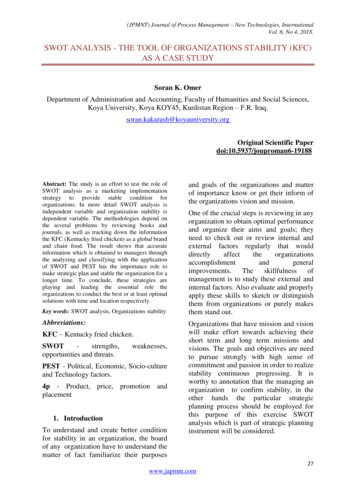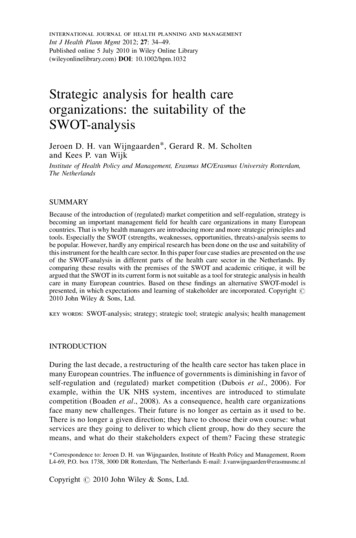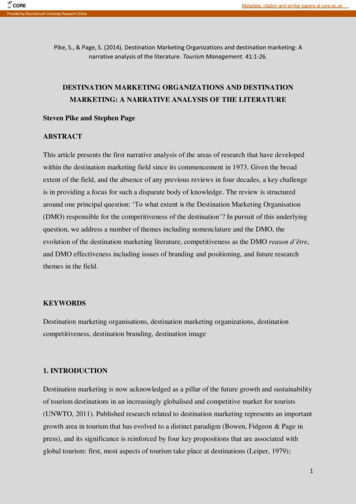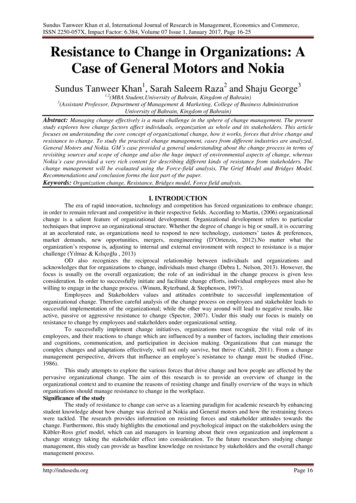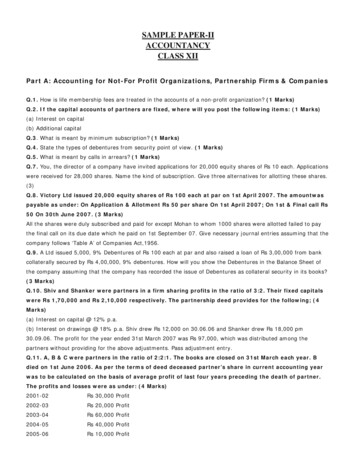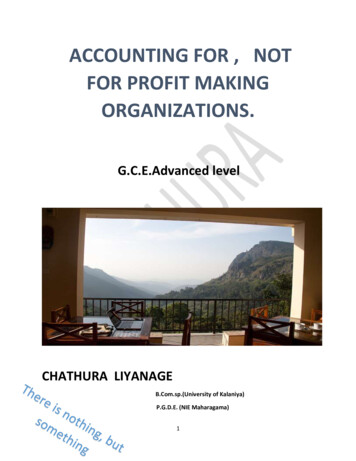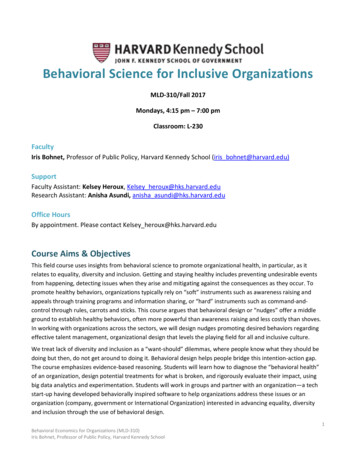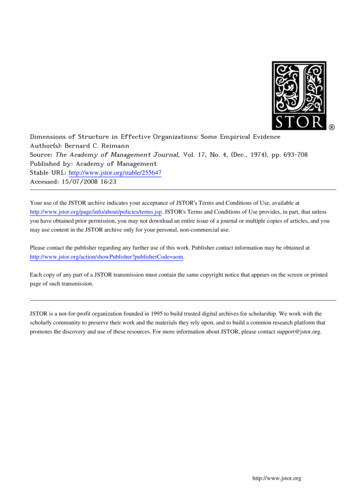
Transcription
2019 International Transaction Journal of Engineering, Management, & Applied Sciences & TechnologiesInternational Transaction Journal of Engineering,Management, & Applied Sciences & Technologieshttp://TuEngr.comANALYSIS OF ORGANIZATIONS WITH A CIRCULARSTRUCTURE (DEMOCRATIC HIERARCHY)Mohammad reza Hamidizadeh a* , Sina Saeedi Asl aaDepartment of Management and Accounting, Shahid Beheshti University, Tehran, IRANARTICLEINFOABSTRACTArticle history:Received 04 January 2019Received in revised form 11March 2019Accepted 12 March 2019Available online13 March 2019The main objective of this study was Analysis of organizations witha circular structure (democratic hierarchy). This was an analyticaldescriptive study and library resources are used to gather information,and content analysis is used to analyze the data. Results showed thatcircular structures have little management levels and small seniormanagement team. The structure can meet lots of hierarchical limitationsand can also cause slowdown of decision making and implementationprocess. It can also decrease high costs of management for interdepartment relates and organizational hierarchy. It enables organizationto consume its resources to provide service for customers (whether thecustomers within organization or out of organization). Circularstructures are rounded structures, which pay attention to processes andtry to preserve the advantages of vertical and horizontal nature. 2019 INT TRANS J ENG MANAG SCI TECH.Keywords:Organizational structure;Structural variables;Content variables;Circular organizationalstructure.1. INTRODUCTIONOrganizational structure and how it has been formed has always been one of the tensediscussions of the field of management. This issue is at the center of attention and in today'sconditions, it has been updated in the form of new contingency theories, reengineering ofthe organization, and so on. Organizational structure is a set of ways and means by whichthe organization divides its workforce into different tasks and then coordinates them. Theorganization, according to its goals and missions, places tasks on its agenda and employsthe staff members, and the distribution of authority and responsibility in the organization isformed. The organizational structure shows itself in a set of lines and forms calledorganizational chart. At the same time, the organizational chart also reflects the views of theminds of managers and designers (Robbins, 2017).Since organizations are open systems and interact with their surroundings, they need tobe redesigned when needed, because of changing the strategy of rival companies, changingtechnology and changing the environment. When designing the structure, the dimensions of*Corresponding author (Mohammad reza Hamidizadeh) E-mail: Aslanpour.mohammad@gmail.com 2019International Transaction Journal of Engineering, Management, & Applied Sciences & Technologies. Volume 10No.3 ISSN2228-9860 eISSN1906-9642 http://TUENGR.COM/V10/409.pdf DOI: 10.14456/ITJEMAST.2019.40409
the organization should be analyzed. Organizational dimensions include content variablesand structural variables. Objectives, strategy, environment, technology, and size are amongthe most important content variables. These variables represent the whole organization andits status and are between the organization and the environment and are derived from theenvironment (Richard, 1997).Complexity, formalization, and concentration are important examples of structuralvariables. Structural variables represent the internal characteristics of an organization andprovide a basis for measuring organizations and comparing their structural features. Contentvariables affect the structural variables and their integration and integration into a variety ofstructural designs that are theoretically divided into organic and mechanical structures, andorganizational structure can be found in terms of organizational chart. For deepunderstanding, the main concepts presented by scientists are at the first analyzed (Hammer,2006). This study tends to define the desired concept in each section with presentation of agood question.2. LITERATURE REVIEWAn organization is a kind of social unit that consists of individuals who are managed toachieve collective goals. For example, organizations are game systems that are heavilyinfluenced by the environment. Each organization has its own management structure, whichdefines the relationships among different employees, the tasks they perform, and the rolesand responsibilities that are provided to perform different tasks. A well-organizedorganization gains effective coordination, identifies the structure, formal communicationchannels, and links individual activities to each other. An organizational structure defines away in which roles, powers, responsibilities, and responsibilities are determined andmanaged and how the information is transmitted between different levels of hierarchy in anorganization. Organizational structure depends considerably on its goals and strategy inachieving those goals. An organizational chart is a visual representation of the organizationalstructure. This structure should clearly define the reporting relationships and the flow ofpower, as this will make a good connection and result in efficient and effective flow of work.Managers should seriously consider how they want to organize an organization. Some of thekey factors that need to be addressed include size of organization, business nature, goals,and business strategy for achieving them and the organization's environment (RahmanzadehHeravi, 2003).2.1 Functional organizational structureOrganizational structure is the most common model in most organizations.Organizations with such a structure are divided into smaller groups such as operational,financial, marketing, human resources, IT, and so on. The top management team consists ofseveral performance supervisors, such as sales and marketing operations manager.Communication occurs in each of the functional sections and is communicated acrosssections through the supervisors of that department. This structure provides moreoperational efficiency. It also allows each group of specialists who have more expertise to410Mohammad reza Hamidizadeh, Sina Saeedi Asl
act independently. In spite of the above benefits, there are some issues and problems withthis structure. When different functional areas arise, people focus only on theirresponsibilities and do not support other functional areas. Specialization is also limited to aspecific field of activity, which limits the field of learning and growth (Frankel, 2003).2.2 The organizational structure of the productThis is another common structure in which organizations are organized with a particulartype of product. Each product category is considered as a separate unit. For example, in aretail business, the structure can be grouped according to production lines (Blue and William1969).2.3 The organizational structure of the productA structured organization with the product classification method, by creating completelyseparate processes from other production lines inside the organization, facilitates internalautonomy. This leads to a deep understanding of the particular product and also promotesinnovation. This possibility focuses on responding to the results (Perrow, 1970; Hage andMickael 1967).2.4 Circular organizational structureA matrix structure is organized for managing various dimensions. Functional teams arealso used to report the level of specialized performance in both horizontal and vertical. Inthis way, employees may belong to a specific functional group, but they will also helpanother team. This type of structure brings employees and managers across sectors togetherto achieve common organizational goals, leading to efficient information exchange andefficiency, and also enables the sectors that cooperate with each other, often for Solve issueswith each other. This structure strengthens incentives among employees and creates ademocratic management mode that searches for team members' inputs before directorsdecide. However, the matrix structure often increases the complexity of the organization. Asreporting is not limited to a single supervisor, employees can show their willingness to thesupervisor who wants to follow it. Such discretion and dual communication lead tocommunication gaps and the division of staff and managers (Paul et al, 1990).3. METHODOLOGYThis is an analytical descriptive study and library resources are used to gatherinformation, and content analysis is used to analyze the data.4. RESULTS AND DISCUSSIONOver the organizational study history, different people have always tried to classifyorganizations based on a basis and foundation and apply some features for each group, inwhich the organizations have same features. To study the organizations, scholars need alogic, using of which they can increase organizational ability to achieve organizational goals.Organizational study means we can derive some features of similar organizations and applythem for other organizations to have more effective management.*Corresponding author (Mohammad reza Hamidizadeh) E-mail: Aslanpour.mohammad@gmail.com 2019International Transaction Journal of Engineering, Management, & Applied Sciences & Technologies. Volume 10No.3 ISSN2228-9860 eISSN1906-9642 http://TUENGR.COM/V10/409.pdf DOI: 10.14456/ITJEMAST.2019.40411
Organizational structure specifies the in-organization information and type, amount andthe way of distributing information within the organization. It can be specified that whatunits gets what information and to whom the information should be given and from whomthe information should be received. Organizational structure shows strategy of organizationand the interaction of organization with the environment and response to environmentalphenomena. (Robbins, 2017).4.1 ORGANIZATIONAL STRUCTURE FEATURESOrganizational structures have criteria to be specified and there are factors affecting thecriteria and bringing different structures for people. Hage (1967) counted some features fororganizational structure, which are known today as structural variables. Other scientists alsopresented content variables, which determine structural variables. In fact, these are samefeatures attributed to organizations in same class and are known as organizational plan:4.1.1 STRUCTURAL VARIABLESComplexity, formalization, centralization, standardization, professionalization, andpersonnel positions are structure variables, the most important of which (complexity andformalization) are analyzed here.4.1.1.1 COMPLEXITYWhen person enters to an organization, the first thing encountered is labor division,hierarchy and job titles. Complexity can be investigated in three levels: Horizontal complexity Vertical complexity Geographical complexity4.1.1.2 FORMALIZATIONThe more complicated technology is, the less formalization would be and the morerepetitive technology is, the more formalization is increased.Increased size of organization and its growth can make organization be directed towardsbureaucracy to control and to have indirect supervision on people and solving problems inlow levels and can ultimately increase formalization. The more the organizational personnelare educated and specialized, the more they can bring rules to the organization and theorganization has to codify less regulations and standards. In fact, the profession of expertscan adjust the organization (Blue and William 1969).4.1.1.3 CENTRALIZATIONCentralization is in direct relationship with power and decision making within theorganization. In fact, centralization shows the distribution of power within the organization.The aim by power is power in decision making. Power distribution in organization can causeformation of different forms of organizational structure. Each group with more power in theorganization has more centralization and forms organizational structure in its own benefit.412Mohammad reza Hamidizadeh, Sina Saeedi Asl
Power has some source and origin, which can't be explained in this study (RahmanzadehHeravi, 2003).4.1.2 CONTENT VARIABLESContent variables are those variables affecting structural variables directly. In fact, theamount of complexity and formality and centralization of organization is depended on thesevariables. Content variables include environment, technology, strategy, size and culture andare explained in the following.Environment: every organization is surrounded by the environment. The first step toanalyze environment is to identify that. Hence, to identify the environment, the eventshappened there should be identified. On the other hand, all said events are taken by theorganizations and human communities. Hence, all organizations and societies shouldidentify the events they create, which are not under control of organization but can affectthat. To this end, organization has been divided to different departments. The longitudinalinstrument of the environment includes far or public environment, near or workenvironment. The latitudinal instrument of the environment includes 10 separated sections.In lateral environment tool, for the analysis of far environment, PESTEL is used and toanalyze near environment, it is used. The difference of near (work) and far (public)environment is that the work environment can affect organizational action daily and directlyand public environment can affect organizational performance and public environment canaffect all organizations of industry indirectly.For analysis of work environment, the industry analysis method, competitor groups'nature and product lifecycle should be applied.Another method for industry analysis is using product lifecycle. In the Figure 1, thiscycle is illustrated.Figure 1: Product life cycle.This kind of classification helps investors to assess the potential growth of differentcompanies in an industry.In analysis of competitor groups based on two underly
An organizational structure defines a way in which roles, powers, responsibilities, and responsibilities are determined and managed and how the information is transmitted between different levels of hierarchy in an organization. Organizational structure depends considerably on its goals and strategy in achieving those goals. An organizational chart is a visual representation of the organizational
